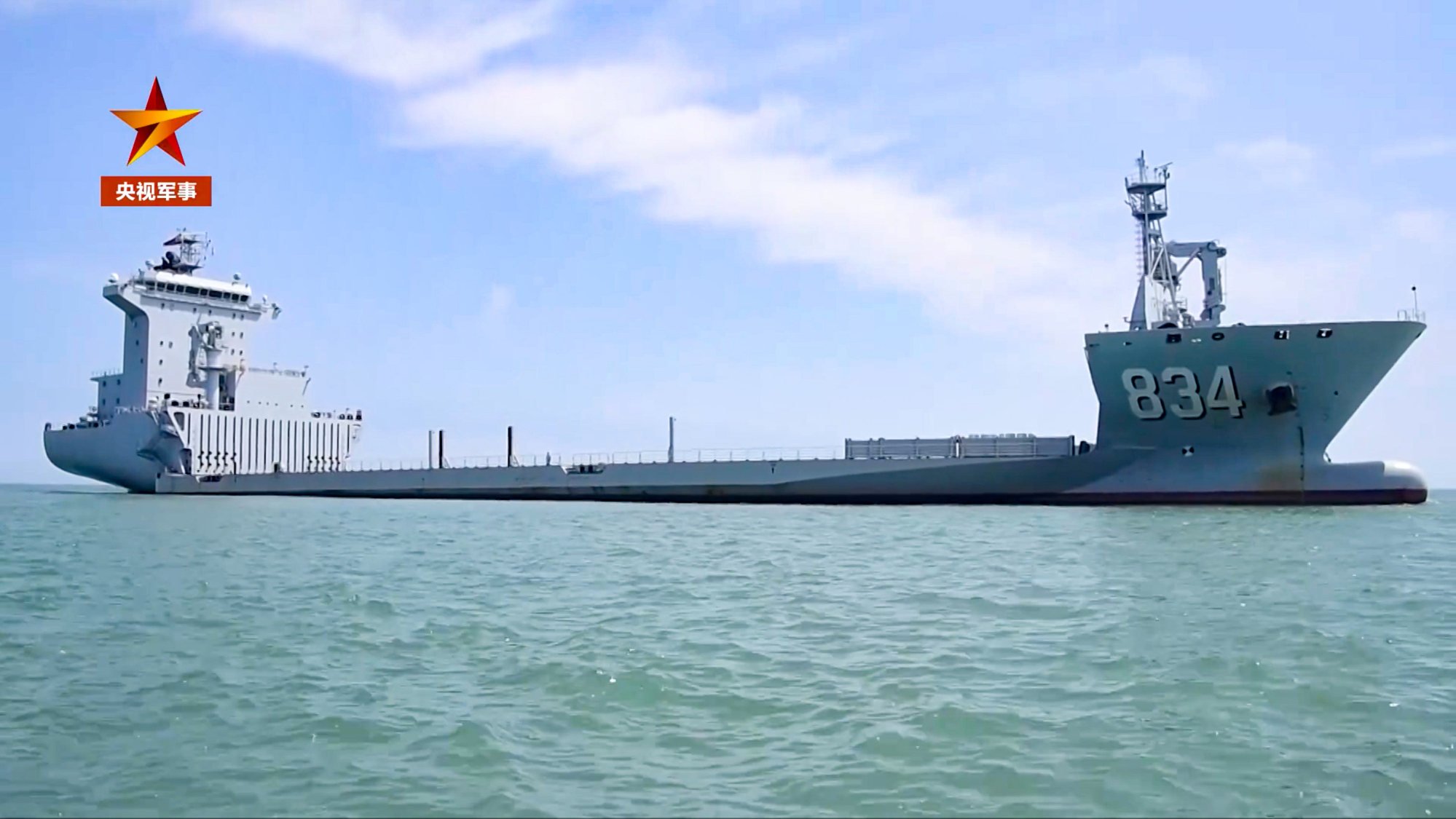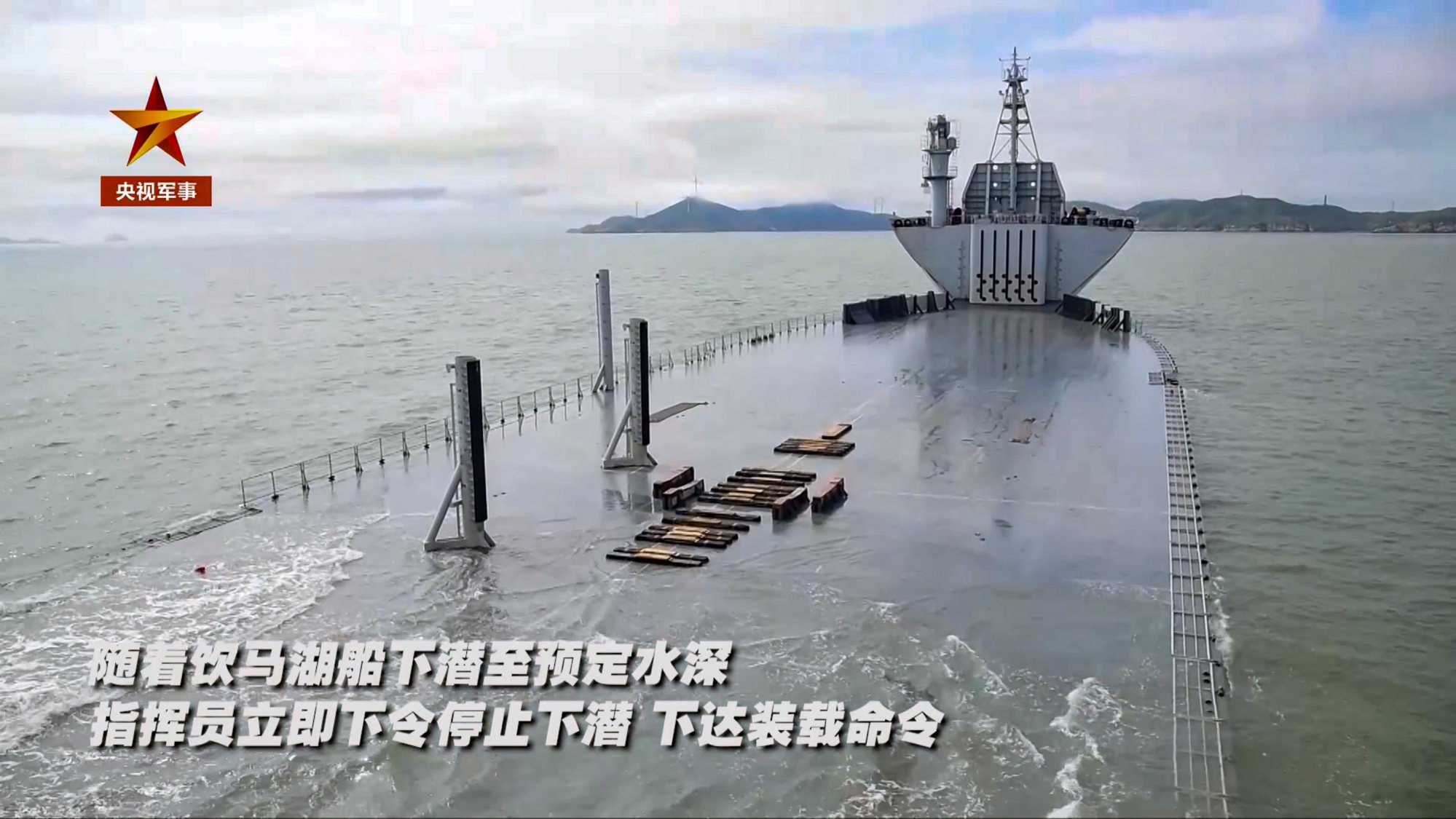 |
| The Chinese navy’s new semi-submersible heavy-lift ship - the Yinmahu - travelled almost 1,000 nautical miles during trials, CCTV reported on Thursday. Photo: CCTV |
- The Yinmahu is a semi-submersible heavy-lift ship that could ferry equipment and ships, rescue damaged vessels and serve as emergency repair dock
- While Chinese state TV showed the ship doing various manoeuvres, it did not reveal the vessel’s specifications or the trial locations
The Chinese navy’s new heavy-lift ship is ferrying other ships during trials as the People’s Liberation Army ramps up its warship projection and rescue capability, state television reported.
The Yinmahu, bearing the hull number 834, ran ship transport trials after travelling almost 1,000 nautical miles to several undisclosed locations recently, CCTV reported on Thursday.
It was a rare revelation about the PLA Navy’s semi-submersible heavy-lift ships, which could play an important role transporting equipment and ships, or rescuing damaged vessels during wartime. It could also serve as a makeshift dock for emergency on-site repairs.
 The Yinmahu could serve as a makeshift dock for emergency on-site repair. Photo: CCTV
The Yinmahu could serve as a makeshift dock for emergency on-site repair. Photo: CCTVFootage showed the Yinmahu’s departure, submerging, ship loading, lifting and transporting. The state media report said the vessel overcame a short preparation time, bad weather and long distances to complete the trial of loading several items and transfer missions.
The state TV report said the training tested “the semi-submersible ship’s capability of accurate delivery and multidimensional support in a condition close to real combat”.
“It not only enhanced the ship’s long-distance delivery capacity, but also expanded its high-sea delivery range from proximity to unfamiliar waters, from general conditions to the extreme conditions.”
The Chinese navy’s new heavy-lift ship is ferrying other ships during trials as the People’s Liberation Army ramps up its warship projection and rescue capability, state television reported.
The Yinmahu, bearing the hull number 834, ran ship transport trials after travelling almost 1,000 nautical miles to several undisclosed locations recently, CCTV reported on Thursday.
It was a rare revelation about the PLA Navy’s semi-submersible heavy-lift ships, which could play an important role transporting equipment and ships, or rescuing damaged vessels during wartime. It could also serve as a makeshift dock for emergency on-site repairs.

Footage showed the Yinmahu’s departure, submerging, ship loading, lifting and transporting. The state media report said the vessel overcame a short preparation time, bad weather and long distances to complete the trial of loading several items and transfer missions.
The state TV report said the training tested “the semi-submersible ship’s capability of accurate delivery and multidimensional support in a condition close to real combat”.
“It not only enhanced the ship’s long-distance delivery capacity, but also expanded its high-sea delivery range from proximity to unfamiliar waters, from general conditions to the extreme conditions.”
China’s advanced Fujian aircraft carrier to start sea trials this year3 Jan 2023

However, CCTV did not reveal the location or the date of the drill, and nor did it give the Yinmahu’s specifications.
It is the first public disclosure about the Yinmahu, which is only the second of its type. The Chinese navy’s first heavy-lift vessel, the Donghaidao (hull number 868) is known to have entered service in 2015.
The semi-submersible heavy-lift ship can carry vessels over 100,000 tonnes. By adjusting the ballast water, it submerges its cargo deck for another vessel to float atop. It then drains the ballast, floats and lifts the load, allowing it to carry the vessel. At the other end of the journey the process is repeated to unload the cargo.
 The state media report said the Yinmahu succeeded in loading and ferrying vessels despite a short preparation time, bad weather and long distances. Photo: CCTV
The state media report said the Yinmahu succeeded in loading and ferrying vessels despite a short preparation time, bad weather and long distances. Photo: CCTVCurrently, most semi-submersible heavy lift ships are commercially run and used for civilian purposes, such as transferring barges, yachts or oil rig platforms.
In 2017, when two 7,000-tonne Arleigh Burke-class guided-missile destroyers – USS McCain and USS Fitzgerald – were seriously damaged in separate collisions, the US Navy hired two Dutch-run heavy lifters, the Treasure and the Transshelf respectively, to ferry them back.
However, CCTV did not reveal the location or the date of the drill, and nor did it give the Yinmahu’s specifications.
It is the first public disclosure about the Yinmahu, which is only the second of its type. The Chinese navy’s first heavy-lift vessel, the Donghaidao (hull number 868) is known to have entered service in 2015.
The semi-submersible heavy-lift ship can carry vessels over 100,000 tonnes. By adjusting the ballast water, it submerges its cargo deck for another vessel to float atop. It then drains the ballast, floats and lifts the load, allowing it to carry the vessel. At the other end of the journey the process is repeated to unload the cargo.

Currently, most semi-submersible heavy lift ships are commercially run and used for civilian purposes, such as transferring barges, yachts or oil rig platforms.
In 2017, when two 7,000-tonne Arleigh Burke-class guided-missile destroyers – USS McCain and USS Fitzgerald – were seriously damaged in separate collisions, the US Navy hired two Dutch-run heavy lifters, the Treasure and the Transshelf respectively, to ferry them back.
What is known about the Fujian, China’s first home-designed aircraft carrier
In the past two decades China has built a major semi-submersible heavy-lift fleet. It has a number of vessels with a loading capacity between 30,000 and 60,000 tonnes.
In 2016, the Chinese firm COSCO Shipping commissioned the world’s second heaviest lift ship, the Xinguanghua, with a load capacity of 100,000 tonnes, second only to the Netherlands’ 110,000-tonne Vanguard. Its deck could submerge to 31 metres deep (101 feet), allowing it to carry Chinese aircraft carrier the Liaoning, which has a 60,000-tonne displacement and a 10-metre draft.
In the past two decades China has built a major semi-submersible heavy-lift fleet. It has a number of vessels with a loading capacity between 30,000 and 60,000 tonnes.
In 2016, the Chinese firm COSCO Shipping commissioned the world’s second heaviest lift ship, the Xinguanghua, with a load capacity of 100,000 tonnes, second only to the Netherlands’ 110,000-tonne Vanguard. Its deck could submerge to 31 metres deep (101 feet), allowing it to carry Chinese aircraft carrier the Liaoning, which has a 60,000-tonne displacement and a 10-metre draft.










No comments:
Post a Comment
How did you like the post, leave a comment. I would appreciate hearing from you all. Best wishes from JC's Naval, Maritime and Military News